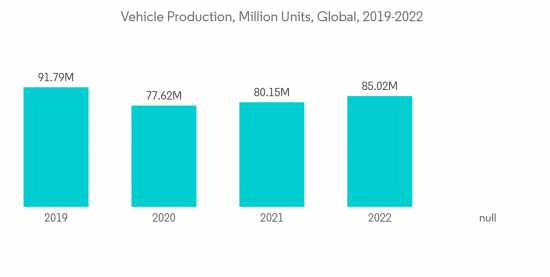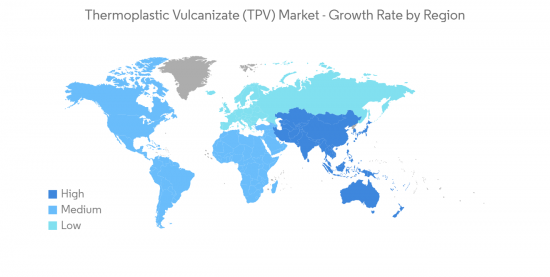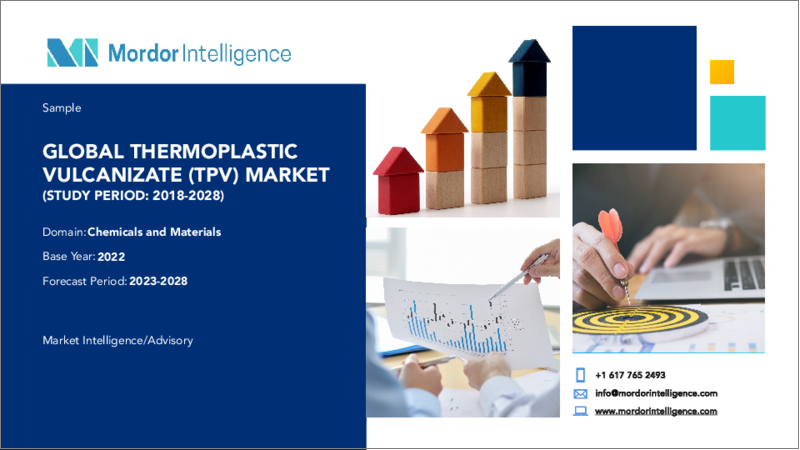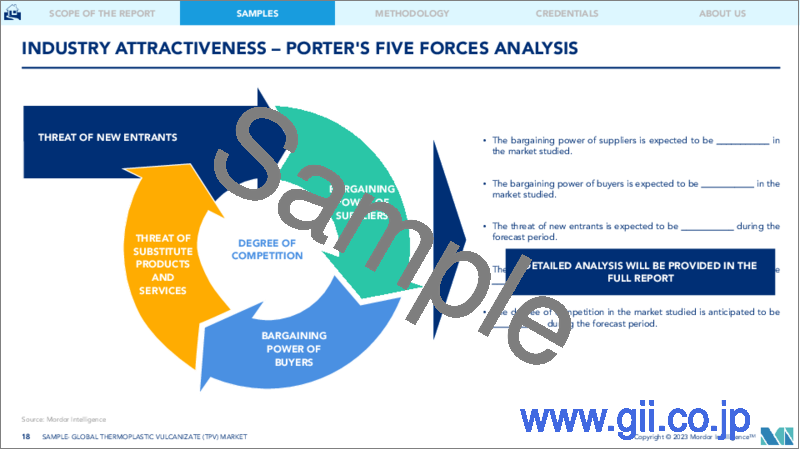|
|
市場調査レポート
商品コード
1331339
動的架橋型熱可塑性エラストマー(TPV)市場規模・シェア分析- 成長動向と予測(2023年~2028年)Thermoplastic Vulcanizate (TPV) Market Size & Share Analysis - Growth Trends & Forecasts (2023 - 2028) |
||||||
|
● お客様のご希望に応じて、既存データの加工や未掲載情報(例:国別セグメント)の追加などの対応が可能です。 詳細はお問い合わせください。 |
|||||||
| 動的架橋型熱可塑性エラストマー(TPV)市場規模・シェア分析- 成長動向と予測(2023年~2028年) |
|
出版日: 2023年08月08日
発行: Mordor Intelligence
ページ情報: 英文 150 Pages
納期: 2~3営業日
|
- 全表示
- 概要
- 目次
動的架橋型熱可塑性エラストマー(TPV)市場規模は、2023年の417.05キロトンから2028年には558.11キロトンに拡大し、予測期間(2023~2028年)のCAGRは6%と予測されます。
COVID-19の大流行により動的架橋型熱可塑性エラストマー市場は混乱し、輸送制限による供給の減少や様々な分野からの需要の減少を招いた。しかし、自動車、建築、建設業界からの需要増加により、2022年に市場は回復しました。
主なハイライト
- 市場を牽引している主な要因は、自動車産業からの需要の急増、消費財産業における利用率の増加、リサイクル可能な材料の使用に関連する有利な政府政策です。
- しかし、耐薬品性や耐摩耗性の低さ、原材料価格の変動は動的架橋型熱可塑性エラストマー市場を抑制する可能性があります。
- ヘルスケア産業での使用拡大と電化製品需要の急増は、市場の主な成長機会になると予想されます。
- アジア太平洋地域は、予測期間において最大の急成長地域となる見込みです。
動的架橋型熱可塑性エラストマー(TPV)市場動向
市場を独占する自動車セグメント
- 自動車用軽量材料は、高級車、低排出ガス車、安全車、高性能車に対する需要の高まりにより、ここ数年で大きく成長しました。
- その結果、サプライヤーとメーカーは、OEMが継続的に強化される規制を満たし、消費者の幅広い嗜好を満たすのに役立つさまざまなソリューションを導入しました。
- 自動車産業におけるTVPの主な用途には、ホースカバー、エアインレットダクトカバー、ガスケット、シール、コンボリュートブーツ、振動ダンパー、ストラットカバー、イグニッションコンポーネント、ブッシュ、ウィンドウシールなどがあります。
- TPVの柔軟な自動車用アンダー・ザ・フード部品には、エアインテーク・チューブやベローズ、ホイールウェル・フレア、ステアリング・システム・ベローズ、消音部品などがあります。
- コストは最大の利点で、TPVはEPDMより10~30%低く、軽量化、設計の柔軟性向上、リサイクル可能性も相まって、TPVはEPDMより10~30%低いです。さらに、TPVは軽量であるため、より低燃費の自動車を実現できます。
- 2022年、国際自動車工業会(OICA)によると、世界の自動車生産台数は、世界の自家用車需要の増加により、前年比6%増加しました。
- 中国では、総自動車生産台数は2億7,020万6,615台で、2022年には前年比3%増となります。また、カナダでは、2022年の総自動車生産台数は12,28,735台で、前年比10%増となっています。
- したがって、上記の要因から、自動車分野が市場を独占すると予想されます。

アジア太平洋地域が急成長
- 中国、日本、インドからの広範な需要は、アジア太平洋市場の需要を牽引する重要な理由のひとつです。
- 中国は世界最大の自動車生産国です。しかし、中国では最近、自動車生産台数が減少しています。景気変動と中国の米国との貿易戦争が自動車産業の業績に影響を与えました。
- 中国は、電気自動車の生産と販売の拡大に注力しています。そのために、中国は電気自動車(EV)の増産を計画しました。国際エネルギー機関(IEA)は、2025年までに中国の新車生産台数に占める電気自動車の割合を20%にすることを目標に掲げています。
- さらに、国際自動車工業会(OICA)によると、2022年の中国の自動車総生産台数は27,020,615台で、2021年に比べて3%増加しました。
- 中国の好景気は、消費財メーカーに世界最大の成長機会を提供しました。中国の消費財市場の巨大な潜在力に惹かれ、多くの外国企業が中国に進出し、生産部門を設立しました。消費財生産の成長に伴い、動的架橋型熱可塑性エラストマーの消費も需要が増加する可能性があります。
- 世界資源研究所(WRI)によると、中国は建設メガブームの真っ只中にあります。同国は世界最大の建築市場であり、世界全体の建設投資の20%を占めています。2030年までに、中国だけで約13兆米ドルの建築投資が見込まれています。
- 日本では、東京が、投資と市場開拓の見通しにおいて、この地域の他の主要都市の中でトップ市場に浮上し、中でも住宅部門が大きなシェアを占めています。
- このように、自動車、建設、消費財産業の成長が見込まれることから、アジア太平洋地域の予測期間中、動的架橋型熱可塑性エラストマーの国内需要が牽引される可能性が高いです。

動的架橋型熱可塑性エラストマー(TPV)産業概要
動的架橋型熱可塑性エラストマー(TPV)市場は統合されており、主要企業が市場シェアの約70%を占めています。主要企業(順不同)には、Exxon Mobil Corporation、三井化学、Teknor Apex、Dawn Group、KUMHO POLYCHEMが含まれます。
その他の特典:
- エクセル形式の市場予測(ME)シート
- 3ヶ月間のアナリスト・サポート
目次
第1章 イントロダクション
- 調査の前提条件
- 調査範囲
第2章 調査手法
第3章 エグゼクティブサマリー
第4章 市場力学
- 促進要因
- 自動車産業からの幅広い需要
- 消費財産業における動的架橋型熱可塑性エラストマーの使用増加
- リサイクル可能な材料の使用に関する有利な政府政策
- 抑制要因
- 耐薬品性と耐摩耗性の低さ
- 原材料価格の変動
- 業界バリューチェーン分析
- ポーターのファイブフォース分析
- 供給企業の交渉力
- 消費者の交渉力
- 新規参入業者の脅威
- 代替品の脅威
- 競合の程度
- 原材料分析
第5章 市場セグメンテーション(市場規模:数量ベース)
- エンドユーザー産業
- 自動車
- 建築・建設
- 消費財
- ヘルスケア
- その他のエンドユーザー産業
- 地域
- アジア太平洋
- 中国
- インド
- 日本
- 韓国
- その他アジア太平洋地域
- 北米
- 米国
- カナダ
- メキシコ
- 欧州
- ドイツ
- 英国
- イタリア
- フランス
- スペイン
- その他欧州
- 南米
- ブラジル
- アルゼンチン
- その他南米
- 中東・アフリカ
- サウジアラビア
- 南アフリカ
- その他中東とアフリカ
- アジア太平洋
第6章 競合情勢
- M&A、合弁事業、提携、協定
- 市場シェア(%)**/ランキング分析
- 主要企業の戦略
- 企業プロファイル
- Avient Corporation
- Celanese Corporation
- Elastron TPE
- Exxon Mobil Corporation
- FM Plastics
- Kumho Polychem
- LCY GROUP
- LyondellBasell Industries holdings B.V.
- Mitsubishi Chemical Corporation
- Mitsui Chemicals Inc.
- Ravago
- RTP Company
- Teknor Apex
- Trinseo
第7章 市場機会と今後の動向
- ヘルスケア産業での用途拡大
- 電気用途での需要拡大
The Thermoplastic Vulcanizate (TPV) Market size is expected to grow from 417.05 kilotons in 2023 to 558.11 kilotons by 2028, at a CAGR of 6% during the forecast period (2023-2028).
The COVID-19 pandemic disrupted the thermoplastic vulcanizate market, resulting in a reduction in supply due to transportation restrictions and a decline in demand from various sectors. Nonetheless, the market rebounded in 2022 due to increased demand from the automotive, building, and construction industries.
Key Highlights
- The major factors driving the market studied are the surge in demand from the automobile industry, the increase in utilization in the consumer goods industry, and favorable government policies related to using recyclable materials.
- However, poor resistance to chemicals and low wear resistance, and fluctuation in raw material prices could restrain the thermoplastic vulcanizate market.
- Growing use in the healthcare industry and surging demand for electrical appliances are expected to be major growth opportunities for the market.
- The Asia-Pacific region is expected to be the largest and fastest-growing region in the forecast period.
Thermoplastic Vulcanizate (TPV) Market Trends
The Automotive Segment to Dominate the Market
- Automotive lightweight materials grew robustly over the past couple of years due to the increasing demand for luxurious, low-on-emission, safe, and high-performance vehicles.
- As a result, suppliers and manufacturers introduced various solutions that help OEMs meet continually tightening regulations and satisfy the widening range of consumers' tastes.
- The major applications of TVP in the automotive industry include hose coverings, air inlet duct covers, gaskets, seals, convoluted boots, vibration dampeners, strut covers, ignition components, bushings, and window seals.
- TPV flexible automotive under-the-hood components include air intake tubes and bellows, wheel well flares, steering system bellows, and sound abatement parts.
- Cost is the biggest advantage, with TPVs being 10-30% lower than EPDM, coupled with lower weight, improved design flexibility, and recyclability. Furthermore, the lightweight of TPV enables more fuel-efficient vehicles.
- In 2022, According to the International Organization of Motor Vehicle Manufacturers (OICA), global automobile production increased by 6% compared to the previous year due to increasing global demand for private mobility.
- In China, the total vehicle production was 270,20,615, with an increase of 3% in 2022 compared to the previous year. Also, in Canada, the total vehicle production was 12,28,735 in 2022, with an increase of 10% in the production of vehicles in the country compared to the previous year.
- Thus, based on the factors above, the automotive segment is expected to dominate the market.

Asia-Pacific to Witness the Fastest Growth
- Extensive demand from China, Japan, and India is one of the key reasons driving the demand in the market in Asia-Pacific.
- China is the world's largest automotive producer. However, the country witnessed a decline in the production of vehicles in the recent past. The economic shifts and China's trade war with the United States affected the automotive industry's performance.
- China is focusing on increasing the production and sales of electric vehicles. For this purpose, the country planned to increase the production of electric vehicles (EVs). It targeted to reach the share of electric vehicles to 20% of China's total new car production by 2025, stated the International Energy Agency (IEA).
- Moreover, according to the International Organization of Motor Vehicle Manufacturers (OICA), in 2022, the total vehicle production in China stood at 27,020,615 units, which increased by 3% compared to 2021.
- China's booming economy offered consumer product companies some of the world's greatest growth opportunities. Attracted by the huge potential of China's consumer goods market, many foreign companies entered China and set up production units. With the growth of consumer goods production, thermoplastic vulcanizate consumption may also see an increased demand.
- According to World Resources Institute (WRI), China is in the middle of a construction mega-boom. The country includes the largest building market in the world, making up 20% of all construction investment globally. The country alone is expected to spend nearly USD 13 trillion on buildings by 2030.
- In Japan, Tokyo emerged as a top market among the rest of the major cities in the region for investments and development prospects, of which the residential sector accounted for the major share.
- Thus, the anticipated growth in the automotive, construction, and consumer goods industries will likely drive the domestic demand for thermoplastic vulcanizate during the forecast period in Asia-Pacific.

Thermoplastic Vulcanizate (TPV) Industry Overview
The thermoplastic vulcanizate (TPV) market is consolidated, with the top players accounting for around 70% of the market share. The major companies (in no particular order) include Exxon Mobil Corporation, Mitsui Chemicals Inc., Teknor Apex, Dawn Group, and KUMHO POLYCHEM.
Additional Benefits:
- The market estimate (ME) sheet in Excel format
- 3 months of analyst support
TABLE OF CONTENTS
1 INTRODUCTION
- 1.1 Study Assumptions
- 1.2 Scope of the Study
2 RESEARCH METHODOLOGY
3 EXECUTIVE SUMMARY
4 MARKET DYNAMICS
- 4.1 Drivers
- 4.1.1 Extensive Demand from the Automobile Industry
- 4.1.2 Increase in Use of Thermoplastic Vulcanizate in the Consumer Goods Industry
- 4.1.3 Favourable Government Policies Related to the Use of Recyclable Materials
- 4.2 Restraints
- 4.2.1 Poor Chemical and Wear Resistance
- 4.2.2 Fluctuation in Raw Material Prices
- 4.3 Industry Value Chain Analysis
- 4.4 Porter's Five Forces Analysis
- 4.4.1 Bargaining Power of Suppliers
- 4.4.2 Bargaining Power of Consumers
- 4.4.3 Threat of New Entrants
- 4.4.4 Threat of Substitute Products and Services
- 4.4.5 Degree of Competition
- 4.5 Raw Material Analysis
5 MARKET SEGMENTATION (Market Size in Volume)
- 5.1 End-user Industry
- 5.1.1 Automotive
- 5.1.2 Building and Construction
- 5.1.3 Consumer Goods
- 5.1.4 Healthcare
- 5.1.5 Other End-user Industries
- 5.2 Geography
- 5.2.1 Asia-Pacific
- 5.2.1.1 China
- 5.2.1.2 India
- 5.2.1.3 Japan
- 5.2.1.4 South Korea
- 5.2.1.5 Rest of Asia-Pacific
- 5.2.2 North America
- 5.2.2.1 United States
- 5.2.2.2 Canada
- 5.2.2.3 Mexico
- 5.2.3 Europe
- 5.2.3.1 Germany
- 5.2.3.2 United Kingdom
- 5.2.3.3 Italy
- 5.2.3.4 France
- 5.2.3.5 Spain
- 5.2.3.6 Rest of Europe
- 5.2.4 South America
- 5.2.4.1 Brazil
- 5.2.4.2 Argentina
- 5.2.4.3 Rest of South America
- 5.2.5 Middle-East and Africa
- 5.2.5.1 Saudi Arabia
- 5.2.5.2 South Africa
- 5.2.5.3 Rest of Middle-East and Africa
- 5.2.1 Asia-Pacific
6 COMPETITIVE LANDSCAPE
- 6.1 Mergers and Acquisitions, Joint Ventures, Collaborations, and Agreements
- 6.2 Market Share(%)**/Ranking Analysis
- 6.3 Strategies Adopted by Leading Players
- 6.4 Company Profiles
- 6.4.1 Avient Corporation
- 6.4.2 Celanese Corporation
- 6.4.3 Elastron TPE
- 6.4.4 Exxon Mobil Corporation
- 6.4.5 FM Plastics
- 6.4.6 Kumho Polychem
- 6.4.7 LCY GROUP
- 6.4.8 LyondellBasell Industries holdings B.V.
- 6.4.9 Mitsubishi Chemical Corporation
- 6.4.10 Mitsui Chemicals Inc.
- 6.4.11 Ravago
- 6.4.12 RTP Company
- 6.4.13 Teknor Apex
- 6.4.14 Trinseo
7 MARKET OPPORTUNITIES AND FUTURE TRENDS
- 7.1 Rising Usage in the Healthcare Industry
- 7.2 Growing Demand in Electrical Applicances




